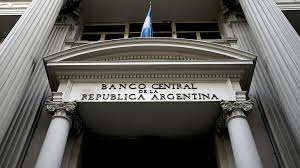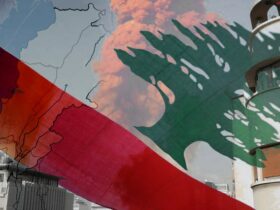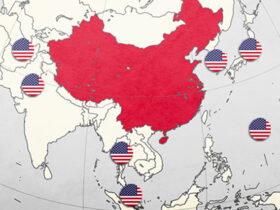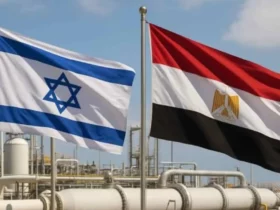By Rodolfo Pablo Treber, Buenos Aires, Argentina *
The President-elect of Argentina, Javier Milei has caused attention with his proposals to dollarize the economy and close down the Argentine Central Bank. Rodolfo Pablo Treber responds to these proposals in an article published 3 days ahead of the second round of elections last Sunday.
Treber is an economic analyst that works for the Central Bank of the Republic of Argentina. The article first appeared in Spanish on PiaGlobal here. Translation by UWI.
It happens that, both in speeches and in deeds, it has been internalized as something watertight and immovable that Argentina must eternally submit to being a factory that supplies raw materials to the most industrially developed countries. In other words, they have resigned themselves, and/or accommodated, to discussing different forms of administration of a colonial Argentina, which should only dedicate itself to increasing its exports, to the detriment of its internal market and the quality of life of its population.
It is there, in that context of resignation, possibility and absence of deep debate on the national development model, where the delirious ideas of solutions based on the destruction of one’s own are born and become strong.
That is why it is important to highlight that both dollarization and the closure of the Central Bank are proposals that would only aggravate the problems of the local economy since they mean a deepening of the destruction of the national productive apparatus and shrinking of the State that has been occurring for 46 years.
Regarding dollarization, price instability in the Argentine economy began after the liberalization and privatization of its foreign trade. Since that moment, both exports made by multinational grain collectors (Cofco, Dreyfus, Cargill, Bunge, ADM), as well as imports of international automotive companies and marketing chains are made in US dollars.
As a consequence of this, every product in the domestic market can be exported, so its price is directly linked to the exchange rate, and the rest does so indirectly due to its relationship in the production and logistics cost structure (fuels, energy, etc.).
Therefore, in our economy – private and totally transnational – the Dollar functions as a standard or support for the Argentine Peso. Thus, the local currency is only a reflection of the dominant foreign currency, and its price is defined according to the amount of dollars in reserve of the Central Bank of the Argentine Republic (BCRA).
This political subordination nullifies monetary sovereignty and the ability to issue, since the latter is conditioned by the amount of dollars that enter the country and have a direct impact on the peso/dollar conversion price, which influences the variation of internal prices.
This dependence on a currency that we do not control, that we do not issue, has serious economic consequences that translate into permanent devaluations and instability in internal prices.
The direct link between such disparate economies, created by foreign trade in foreign hands, produces constant devaluations that, when directly or indirectly translated into an increase in prices, hurt the Argentine people.
A clear example: The houses are 100% manufactured in the country, but bricks, cement, sand, and all construction materials are susceptible to purchase/sale abroad. Therefore, companies impose the dollar price of foreign trade to avoid losing profitability and ensure their profits. The same thing is repeated in each of the country’s productive sectors and is aggravated by the enormous amounts of imported inputs and goods that exist and have their price, directly, in foreign currency.
So, the dollar is the cause of the problems of the Argentine economy. It can never be its solution.
Dollarization would have dire consequences. The first and immediate one would be the destruction of purchasing power, given that the existing foreign currencies would be enough for an average salary of approximately 70 dollars per month, an amount with which 90% of the population would remain below the poverty line. The second is that in the short term all national companies would begin to compete with foreign industry. Therefore, the entire national productive network would end up being destroyed, causing massive unemployment. And, finally, it would nullify any response capacity on the part of the governments in power since the issuance, interest rate and political conditions would be imposed by the United States. This is the total annulment of national sovereignty.
The real solution, the conflict to be faced, is totally opposite to the current debate: We must reconquer sovereignty and pacify the national economy.
Central Bank of the Argentine Republic: A necessary pillar for productive development.
Focusing on the administration of Argentine savings, banking and finance, it is important to recognize that the generation, hoarding and distribution of money constitute a powerful tool that can be used either to promote or stop production. To achieve this, it is enough to grant credits (or not) to the industry, or to make interest payments viable (or not) according to the applicable rate. Consequently, a production and employment generation plan are largely subordinated to banking.
The Central Bank of the Argentine Republic was designed at the beginning of the 1930s, and formally established in 1935, due to the need to plan national credit and investment in a geopolitical context where the industrial destruction, which produced the First World War, prevented developed countries from having surplus production to sell to the rest of the world. Thus, Argentina, governed by fierce liberalism, was forced to begin a process of industrialization by import substitution. Yes, liberalism itself was the one who had to create the BCRA to plan investment and production.
Then, in 1946, during Perón’s first government, the entire BCRA (which until then was managed by a group of private banks) was nationalized to deepen and federalize industrialization. It turns out that, until that moment, productive investments only went to the most profitable sectors and did not consider the popular interest, nor the main objective of generating employment.
Thus, from the state planning of financial resources, the largest process of industrialization, development, generation and distribution of wealth in Argentine history was carried out.
For the naval industry, the Río Santiago Shipyard was created in 1948, which was perfected and made more complex in 1953 with the creation of AFNE (State Shipyard and Naval Factories), giving birth to a process that would lead to Argentina having the world’s 5th largest merchant fleet in the 70s.
The solid foundations of the automotive and aeronautical industries were also created. On November 30, 1951, the Motor and Automotive Factory was created in Córdoba and on March 28, 1952, the Military Aircraft Factory IAME Aeronautical and Mechanical Industries of the State was created.
With economic planning from the BCRA, the necessary investments were made for the start of the national steel industry through the work of General Savio, the development of YPF was promoted, and Gas del Estado was created with large infrastructure works that expanded as never energy production.
All of this, plus the construction of thousands of homes, schools, roads and hospitals, would not have been possible without the BCRA and the national and centralized administration of financial resources.
The BCRA, today.
Inevitably, to start an industrialization project that recovers work for Argentines, abundant investment capital is required. This is going in search of foreign investments, which then end in conditions, loss of sovereignty and a flight of capital exponentially greater than the initial income, but, on the contrary, it means rescuing the economic resources of the Argentine people that, today, are parasitized in the speculative world or in the hands of private and transnational banks.
In this sense, and diametrically opposed to what the national interest indicates, the Argentine financial system is dedicated exclusively to financial speculation. To substantiate this, it is only necessary to say that the monetary base (the total of banknotes issued in the hands of the public plus what is deposited in banks) is currently 7.7 trillion pesos, while what is deposited in financial instruments, “leliqs , notaliqs and passive repos from the BCRA”, adds up to 23 billion pesos (300% of the Monetary Base) charging an annual interest rate of 133%. This enormous volume of money has no contact with the real economy and generates an issue, due to interest, of 2.5 trillion pesos per month, 84,000 million per day (data as of 11/09/23), while it is reported that there is no money and cuts are generated in education, health and housing to meet the fiscal adjustment goals imposed by the IMF.
It is clear that, while the national economy is in crisis, the financial world, totally disconnected from the real economy, continues to obtain huge profits. But it is also clear that, if we make the political decision to manage these resources, we have sufficient funds to face the urgent problems of the situation and direct the savings of the Argentine people to a productive development model that generates genuine jobs.
Therefore, as a counter position to the idea of closing the BCRA, which would bury any possibility of development and aggravate the current problems of disinvestment and accumulation of wealth, we need, more than ever, to recover the historical role of the Central Bank to guide the enormous flow of money, today destined for financial speculation, for credit for investment for productive purposes and which, once again, is the pillar of economic planning and national industrialization.
Dollarization and the closure of the BCRA are concrete proposals for national disintegration.
The strengthening of the Argentine peso through industrialization and national administration of the financial system are part of a patriotic agenda to stop looting and promote economic development. It is our responsibility, of the militancy, to organize to twist this reality and to once again occupy the center of the political debate in Argentina.
Rodolfo Pablo Treber * Economic analyst who works for the Central Bank of Argentina.

















Leave a Reply